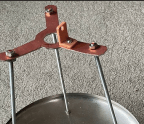The 2022 CQ World-Wide RTTY DX Contest

I. OBJECTIVE
For amateurs around the world to contact as many other amateurs in as many CQ zones, countries, and W/VE QTHs as possible, using only Baudot RTTY (see Rule IX.,10).
II. BANDS
Five bands only: The 3.5-, 7-, 14-, 21- and 28-MHz bands. Observance of established band plans is strongly encouraged.
III. CONTEST EXCHANGE
RST report plus CQ Zone (e.g., 599 05). Stations in the continental USA and Canada also send QTH (e.g., 599 05 MA). See IV.C.3. below.
IV. SCORING:
A. Score: The final score is the result of the total QSO points multiplied by the sum of zone, country, and QTH multipliers. Example: 1,000 QSO points * (30 Zones + 70 Countries + 35 W/VE QTHs) = 135,000 (final score).
B. QSO Points: Stations may be contacted once on each band. QSO points are based on the location of the station worked.
1. Contacts between stations on different continents count three (3) points.
2. Contacts between stations on the same continent but in different countries count two (2) points.
3. Contacts between stations in the same country count one (1) point.
C. Multiplier: There are three (3) types of multipliers.
1. Zone: A multiplier of one (1) for each different CQ Zone contacted on each band. The CQ Worked All Zones rules are the standard.
2. Country: A multiplier of one (1) for each different country contacted on each band. The DXCC entity list, Worked All Europe (WAE) multiplier list plus IG9/IH9, and continental boundaries are the standards for defining country multipliers. Maritime mobile stations count only for a zone multiplier.
3. W/VE
You’re reading a preview, subscribe to read more.
Start your free 30 days

